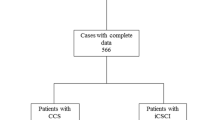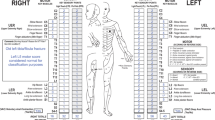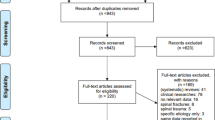Abstract
Central cord syndrome (CCS) is the most common, yet most controversial, among the different spinal cord injury (SCI) incomplete syndromes. Since its original description in 1954, many variations have been described while maintaining the core characteristic of disproportionate weakness in the upper extremities compared to the lower extremities. Several definitions have been proposed in an attempt to quantify this difference, including a widely accepted criterion of ≥10 motor points in favor of the lower extremities. Nevertheless, recent reports have recommended revisiting the terminology and criteria of CCS as existing definitions do not capture the entire essence of the syndrome. Due to methodological differences, the full extent of CCS is not known, and a large variation in prevalence has been described. This review classifies the different definitions of CCS and describes some inherent limitations, highlighting the need for universal quantifiable criteria.
This is a preview of subscription content, access via your institution
Access options
Subscribe to this journal
Receive 12 print issues and online access
$259.00 per year
only $21.58 per issue
Buy this article
- Purchase on Springer Link
- Instant access to full article PDF
Prices may be subject to local taxes which are calculated during checkout






Similar content being viewed by others
References
Nowak DD, Lee JK, Gelb DE, Poelstra KA, Ludwig SC. Central cord syndrome. J Am Acad Orthop Surg. 2009;17:756–65.
Bosch A, Stauffer ES, Nickel VL. Incomplete traumatic quadriplegia. A ten-year review. JAMA 1971;216:473–8.
Engel-Haber E, Botticello A, Snider B, Kirshblum S. Incomplete Spinal Cord Syndromes: Current Incidence and Quantifiable Criteria for Classification. J Neurotrauma. 2022;39:1687–96.
Van Middendorp JJ, Pouw MH, Hayes KC, Williams R, Chhabra HS, Putz C, et al. Diagnostic criteria of traumatic central cord syndrome. Part 2: A questionnaire survey among Spine specialists. Spinal Cord. 2010;48:657–63.
Avila MJ, Hurlbert RJ. Central Cord Syndrome Redefined. Neurosurg Clin. 2021;32:353–63.
Smith É. Is it time to redefine or rename the term “Central Cord Syndrome”? Spinal Cord. 2021;59:935–6.
Badhiwala JH, Wilson JR, Fehlings MG. The case for revisiting central cord syndrome. Spinal Cord. 2020;58:125–7.
Pouw MH, Van Middendorp JJ, Van Kampen A, Curt A, Van De Meent H, Hosman AJF. Diagnostic criteria of traumatic central cord syndrome. Part 3: Descriptive analyses of neurological and functional outcomes in a prospective cohort of traumatic motor incomplete tetraplegics. Spinal Cord. 2011;49:614–22.
Blasetti G, Pavese C, Maier DD, Weidner N, Rupp R, Abel R, et al. Comparison of outcomes between people with and without central cord syndrome. Spinal Cord. 2020;58:1263–73.
Guest J, Eleraky MA, Apostolides PJ, Dickman CA, Sonntag VKH. Traumatic central cord syndrome: results of surgical management. J Neurosurg. 2002;97:25–32.
Lenehan B, Fisher CG, Vaccaro A, Fehlings M, Aarabi B, Dvorak MF. The urgency of surgical decompression in acute central cord injuries with spondylosis and without instability. Spine (Philos Pa 1976). 2010;35:S180–6.
Yamazaki T, Yanaka K, Fujita K, Kamezaki T, Uemura K, Nose T. Traumatic central cord syndrome: analysis of factors affecting the outcome. Surg Neurol. 2005;63:95–100.
Penrod LE, Hegde SK, Ditunno JF. Age effect on prognosis for functional recovery in acute, traumatic central cord syndrome. Arch Phys Med Rehabil. 1990;71:963–8.
Harrop JS, Sharan A, Ratliff J. Central cord injury: pathophysiology, management, and outcomes. Spine J 2006;6:S198–206.
Levi AD, Schwab JM. A critical reappraisal of corticospinal tract somatotopy and its role in traumatic cervical spinal cord syndromes. J Neurosurg Spine. 2022;36:653–9.
Thorburn W. Cases of injury to the cervical region of the spinal cord. Brain 1887;9:510–43.
Schneider RC, Cherry G, Pantek H. The syndrome of acute central cervical spinal cord injury; with special reference to the mechanisms involved in hyperextension injuries of cervical spine. J Neurosurg. 1954;11:546–77.
Taylor AR, Blackwood W. Paraplegia in hyperextension cervical injuries with normal radiographic appearances. J Bone Jt Surg. 1948;30 B:245–8.
Taylor AR. The mechanism of injury to the spinal dord in the neck without damage to the vertebral column. J Bone Jt Surg. 1951;33 B:543–7.
Levi ADO, Tator CH, Bunge RP. Clinical syndromes associated with disproportionate weakness of the upper versus the lower extremities after cervical spinal cord injury. Neurosurgery 1996;38:179–85.
Jimenez O, Marcillo A, Levi ADO. A histopathological analysis of the human cervical spinal cord in patients with acute traumatic central cord syndrome. Spinal Cord. 2000;38:532–7.
Quencer RM, Bunge RP, Egnor M, Green BA, Puckett W, Naidich TP, et al. Acute traumatic central cord syndrome: MRI-pathological correlations. Neuroradiology 1992;34:85–94.
Morecraft RJ, Stilwell-Morecraft KS, Ge J, Kraskov A, Lemon RN. Lack of somatotopy among corticospinal tract fibers passing through the primate craniovertebral junction and cervical spinal cord: pathoanatomical substrate of central cord syndrome and cruciate paralysis. J Neurosurg. 2021;136:1395–409.
Pappas CTE, Gibson AR, Sonntag VKH. Decussation of hind-limb and fore-limb fibers in the monkey corticospinal tract: relevance to cruciate paralysis. J Neurosurg. 1991;75:935–40.
American Spinal Injury Association Standards for neurological classification of spinal injured patients. Chicago, IL: ASIA; 1982.
American Spinal Injury Association Standards for Neurological Classification of Spinal Injury Patients. Chicago, IL; 1989.
American Spinal Injury Association: International Standards for Neurological and Functional Classification of Spinal Cord Injury, revised 2019; Richmond, VA.
Kirshblum SC, Burns SP, Biering-Sorensen F, Donovan W, Graves DE, Jha A, et al. International standards for neurological classification of spinal cord injury (revised 2011). J Spinal Cord Med. 2011;34:535–46.
American Spinal Injury Association: International Standards for Neurological Classification of Spinal Cord Injury, Updated 2015; Atlanta, GA.
Kepler CK, Kong C, Schroeder GD, Hjelm N, Sayadipour A, Vaccaro AR, et al. Early outcome and predictors of early outcome in patients treated surgically for central cord syndrome. J Neurosurg Spine. 2015;23:490–4.
Collignon F, Martin D, Lenelle J, Stevenaert A. Acute traumatic central cord syndrome: magnetic resonance imaging and clinical observations. J Neurosurg. 2002;96:29–33.
Bohlman HH. Acute fractures and dislocations of the cervical spine. An analysis of three hundred hospitalized patients and review of the literature. J Bone Jt Surg Am. 1979;61:1119–42.
Pouw MH, Van Middendorp JJ, Putz C, Re: Hohl JB, Lee JY, Horton JA, et al. A novel classification system for traumatic central cord syndrome: the Central Cord Injury Scale (CCIS). Spine (Philos Pa 1976). 2010;35:E238–43.
Maroon JC. “Burning hands” in football spinal cord injuries. JAMA 1977;238:2049–51.
Anderson DG, Sayadipour A, Limthongkul W, Martin ND, Vaccaro A, Harrop JS. Traumatic central cord syndrome: neurologic recovery after surgical management. Am J Orthop (Belle Mead NJ). 2012;41:E104–8.
Ronzi Y, Perrouin-Verbe B, Hamel O, Gross R. Spinal cord injury associated with cervical spinal canal stenosis: Outcomes and prognostic factors. Ann Phys Rehabil Med. 2018;61:27–32.
Sisto SA, Lorenz DJ, Hutchinson K, Wenzel L, Harkema SJ, Krassioukov A. Cardiovascular status of individuals with incomplete spinal cord injury from 7 NeuroRecovery Network rehabilitation centers. Arch Phys Med Rehabil. 2012;93:1578–87.
Furusawa K, Tokuhiro A, Ikeda A, Tajima F, Uchida R, Tominaga T, et al. Effect of age on bowel management in traumatic central cord syndrome. Spinal Cord. 2012;50:51–6.
Badhiwala JH, Wilson JR, Kulkarni AV, Kiss A, Harrop JS, Vaccaro AR, et al. A Novel Method to Classify Cervical Incomplete Spinal Cord Injury Based on Potential for Recovery: A Group-Based Trajectory Analysis. J Neurotrauma. 2022;39:1654–64.
Wirz M, Zörner B, Rupp R, Dietz V. Outcome after incomplete spinal cord injury: Central cord versus Brown-Sequard syndrome. Spinal Cord. 2010;48:407–14.
Badhiwala JH, Wilson JR, Harrop JS, Vaccaro AR, Aarabi B, Geisler FH, et al. Early vs Late Surgical Decompression for Central Cord Syndrome. JAMA Surg. 2022;157:1024–32.
Ramey WL, Reyes AA, Avila MJ, Hurlbert RJ, Chapman JR, Dumont TM. The Central Cord Score: A Novel Classification and Scoring System Specific to Acute Traumatic Central Cord Syndrome. World Neurosurg. 2021;156:e235–42.
Grassner L, Wutte C, Klein B, Mach O, Riesner S, Panzer S, et al. Early Decompression (< 8 h) after Traumatic Cervical Spinal Cord Injury Improves Functional Outcome as Assessed by Spinal Cord Independence Measure after One Year. J Neurotrauma. 2016;33:1658–66.
Kopp MA, Lübstorf T, Blex C, Schwab JM, Grittner U, Auhuber T, et al. Association of age with the timing of acute spine surgery–effects on neurological outcome after traumatic spinal cord injury. Eur Spine J. 2022;31:56–69.
Hukuda S, Mochizuki T, Ogata M, Shichikawa K, Shimomura Y. Operations for cervical spondylotic myelopathy. A comparison of the results of anterior and posterior procedures. J Bone Jt Surg Br. 1985;67:609–15.
Denis AR, Feldman D, Thompson C, Mac-Thiong JM. Prediction of functional recovery six months following traumatic spinal cord injury during acute care hospitalization. J Spinal Cord Med. 2018;41:309–17.
Khorasanizadeh MH, Yousefifard M, Eskian M, Lu Y, Chalangari M, Harrop JS, et al. Neurological recovery following traumatic spinal cord injury: a systematic review and meta-analysis. J Neurosurg Spine. 2019;30:683–99.
Bulloch LR, Spector L, Patel A. Acute Traumatic Myelopathy: Rethinking Central Cord Syndrome. J Am Acad Orthop Surg. 2022;30:1099–107.
Merriam WF, Taylor TK, Ruff SJ, McPhail MJ. A reappraisal of acute traumatic central cord syndrome. J Bone Jt Surg Br. 1986;68:708–13.
Waters RL, Adkins RH, Sie IH, Yakura JS. Motor recovery following spinal cord injury associated with cervical spondylosis: a collaborative study. Spinal Cord. 1996;34:711–5.
Kuhle J, Gaiottino J, Leppert D, Petzold A, Bestwick JP, Malaspina A, et al. Serum neurofilament light chain is a biomarker of human spinal cord injury severity and outcome. J Neurol Neurosurg Psychiatry. 2015;86:273–9.
Pouw MH, van Middendorp JJ, van Kampen A, Hirschfeld S, Veth RPH, Curt A, et al. Diagnostic criteria of traumatic central cord syndrome. Part 1: a systematic review of clinical descriptors and scores. Spinal Cord. 2010;48:652–6.
Readdy WJ, Whetstone WD, Ferguson AR, Talbott JF, Inoue T, Saigal R, et al. Complications and outcomes of vasopressor usage in acute traumatic central cord syndrome. J Neurosurg Spine. 2015;23:574–80.
Gil-Agudo A, Pérez-Nombela S, Pérez-Rizo E, Del Ama-Espinosa A, Crespo-Ruiz B, Pons JL. Comparative biomechanical analysis of gait in patients with central cord and Brown-Séquard syndrome. Disabil Rehabil. 2013;35:1869–76.
Zheng C, Yu Q, Shan X, Zhu Y, Lyu F, Ma X, et al. Early Surgical Decompression Ameliorates Dysfunction of Spinal Motor Neuron in Patients with Acute Traumatic Central Cord Syndrome: An Ambispective Cohort Analysis. Spine (Philos Pa 1976). 2020;45:E829–38.
Xu GY, Lu X, Zhang YX, Xu S, Yu QF, Song J, et al. The Relationship Between Preoperative Cervical Sagittal Balance and Clinical Outcome of Acute Traumatic Central Cord Syndrome. World Neurosurg. 2022;162:e468–74.
Hayes KC, Hsieh JT, Wolfe DL, Potter PJ, Delaney GA. Classifying incomplete spinal cord injury syndromes: algorithms based on the International Standards for Neurological and Functional Classification of Spinal Cord Injury Patients. Arch Phys Med Rehabil. 2000;81:644–52.
McKinley W, Santos K, Meade M, Brooke K. Incidence and outcomes of spinal cord injury clinical syndromes. J Spinal Cord Med. 2007;30:215–24.
Anderson KK, Tetreault L, Shamji MF, Singh A, Vukas RR, Harrop JS, et al. Optimal Timing of Surgical Decompression for Acute Traumatic Central Cord Syndrome: A Systematic Review of the Literature. Neurosurgery 2015;77:S15–32.
Aarabi B, Koltz M, Ibrahimi D. Hyperextension cervical spine injuries and traumatic central cord syndrome. Neurosurg Focus. 2008;25:E9.
Alexeeva N, Broton JG, Suys S, Calancie B. Central Cord Syndrome of Cervical Spinal Cord Injury: Widespread Changes in Muscle Recruitment Studied by Voluntary Contractions and Transcranial Magnetic Stimulation. Exp Neurol. 1997;148:399–406.
Miranda P, Gomez P, Alday R. Acute traumatic central cord syndrome: analysis of clinical and radiological correlations. J Neurosurg Sci. 2008;52:107–12.
Newey ML, Sen PK, Fraser RD. The long-term outcome after central cord syndrome: a study of the natural history. J Bone Jt Surg Br. 2000;82:851–5.
Tow AM, Kong KH. Central cord syndrome: functional outcome after rehabilitation. Spinal Cord. 1998;36:156–60.
Lawlor BD, Stolp-Smith KA. A new dynamic triceps-driven orthosis (DTDO): achieving elbow flexion in patients with C5 deficits. Arch Phys Med Rehabil. 1998;79:1309–11.
Roth EJ, Lawler MH, Yarkony GM. Traumatic central cord syndrome: clinical features and functional outcomes. Arch Phys Med Rehabil. 1990;71:18–23.
Dai L, Jia L. Acute central cervical cord injury presenting with only upper extremity involvement. Int Orthop. 1997;21:380–2.
Asazuma T, Satomi K, Suzuki N, Fujimura Y, Hirabayashi K. Management of patients with an incomplete cervical spinal cord injury. Spinal Cord. 1996;34:620–5.
Ishida Y, Tominaga T. Predictors of neurologic recovery in acute central cervical cord injury with only upper extremity impairment. Spine (Philos Pa 1976). 2002;27:1652–8.
Chu K, deSouza IS. An unusual case of burning hands. Am J Emerg Med. 2021;48:276–8.
Bell HS. Paralysis of both arms from injury of the upper portion of the pyramidal decussation: “cruciate paralysis”. J Neurosurg. 1970;33:376–80.
Hopkins B, Khanna R, Dahdaleh NS. Revisiting cruciate paralysis: A case report and systematic review. J Craniovertebr Junct Spine. 2016;7:265–72.
Dickman CA, Hadley MN, Pappas CTE, Sonntag KH, Geisler FH. Cruciate paralysis: a clinical and radiographic analysis of injuries to the cervicomedullary junction. J Neurosurg. 1990;73:850–8.
Lenehan B, Street J, O’Toole P, Siddiqui A, Poynton A. Central cord syndrome in Ireland: The effect of age on clinical outcome. Eur Spine J. 2009;18:1458–63.
Hardy AG. Cervical spinal cord injury without bony injury. Spinal Cord. 1977;14:296–305.
Dvorak MF, Fisher CG, Hoekema J, Boyd M, Noonan V, Wing PC, et al. Factors predicting motor recovery and functional outcome after traumatic central cord syndrome: A long-term follow-up. Spine (Philos Pa 1976). 2005;30:2303–11.
Shrosbree RD. Acute central cervical spinal cord syndrome-aetiology, age incidence and relationship to the orthopaedic injury. Paraplegia 1977;14:251–8.
Levi L, Wolf A, Mirvis S, Rigamonti D, Fianfaca MS, Monasky M. The significance of dorsal migration of the cord after extensive cervical laminectomy for patients with traumatic central cord syndrome. J Spinal Disord. 1995;8:289–95.
Schroeder GD, Kepler CK, Hjelm N, Vaccaro AR, Weinstein MS. The effect of vertebral fracture on the early neurologic recovery in patients with central cord syndrome. Eur Spine J. 2015;24:985–9.
Bertelli JA, Ghizoni MF. Transfer of nerve branch to the brachialis to reconstruct elbow extension in incomplete tetraplegia: case report. J Hand Surg Am. 2012;37:1990–3.
Thompson C, Mutch J, Parent S, Mac-Thiong JM. The changing demographics of traumatic spinal cord injury: An 11-year study of 831 patients. J Spinal Cord Med. 2015;38:214–23.
Frankel HL, Hancock DO, Hyslop G, Melzak J, Michaelis LS, Ungar GH, et al. The value of postural reduction in the initial management of closed injuries of the spine with paraplegia and tetraplegia. Spinal Cord. 1969;7:179–92.
Hohl JB, Lee JY, Horton JA, Rihn JA. A novel classification system for traumatic central cord syndrome: the central cord injury scale (CCIS. Spine (Phila Pa 1976). 2010;35:E238–43.
Noonan VK, Kopec JA, Zhang H, Dvorak MF. Impact of Associated Conditions Resulting From Spinal Cord Injury on Health Status and Quality of Life in People With Traumatic Central Cord Syndrome. Arch Phys Med Rehabil. 2008;89:1074–82.
Aito S, D’Andrea M, Werhagen L, Farsetti L, Cappelli S, Bandini B, et al. Neurological and functional outcome in traumatic central cord syndrome. Spinal Cord. 2007;45:292–7.
Chen TY, Lee ST, Lui TN, Wong CW, Yeh YS, Tzaan WC, et al. Efficacy of surgical treatment in traumatic central cord syndrome. Surg Neurol. 1997;48:435–41.
Weingarden SI, Graham PM. Falls resulting in spinal cord injury: patterns and outcomes in an older population. Paraplegia 1989;27:423–7.
Aarabi B, Alexander M, Mirvis SE, Shanmuganathan K, Chesler D, Maulucci C, et al. Predictors of outcome in acute traumatic central cord syndrome due to spinal stenosis. J Neurosurg Spine. 2011;14:122–30.
Lessing NL, Lazaro A, Zuckerman SL, Leidinger A, Rutabasibwa N, Shabani HK, et al. Nonoperative treatment of traumatic spinal injuries in Tanzania: who is not undergoing surgery and why? Spinal Cord. 2020;58:1197–205.
Funding
This study was supported in part by a grant from the National Institute on Disability, Independent Living, and Rehabilitation Research (NIDILRR grant no. 90SIMS0012).
Author information
Authors and Affiliations
Contributions
EEH: Conceptualization; writing—original draft; writing—review and editing. BS: Writing—review and editing. SK: Conceptualization; writing—original draft; writing—review and editing; supervision.
Corresponding author
Ethics declarations
Competing interests
The authors declare no competing interests.
Additional information
Publisher’s note Springer Nature remains neutral with regard to jurisdictional claims in published maps and institutional affiliations.
Rights and permissions
Springer Nature or its licensor (e.g. a society or other partner) holds exclusive rights to this article under a publishing agreement with the author(s) or other rightsholder(s); author self-archiving of the accepted manuscript version of this article is solely governed by the terms of such publishing agreement and applicable law.
About this article
Cite this article
Engel-Haber, E., Snider, B. & Kirshblum, S. Central cord syndrome definitions, variations and limitations. Spinal Cord 61, 579–586 (2023). https://doi.org/10.1038/s41393-023-00894-2
Received:
Revised:
Accepted:
Published:
Issue Date:
DOI: https://doi.org/10.1038/s41393-023-00894-2



